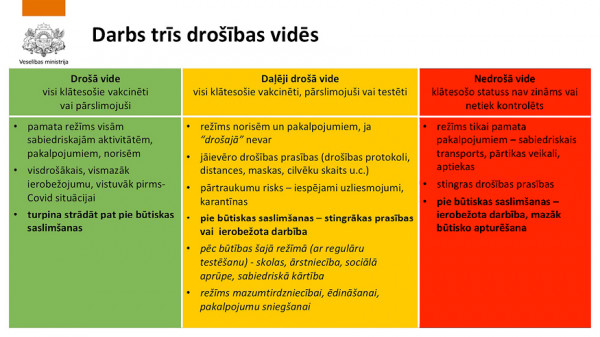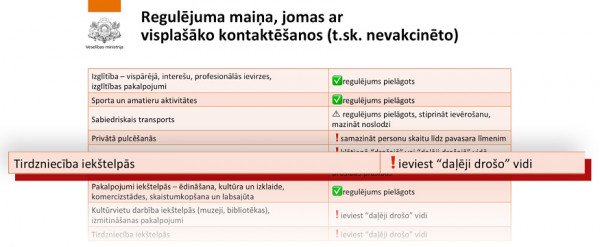There's a risk of serious restrictions on trade being imposed
At this week's government meeting, ministers sought to agree in principle on restrictions on shops and other places where people gather, depending on the rise in the incidence of Covid-19. The meeting ended with the intention to prepare a package by next week with a government order and amendments to the existing anti-Covid regulations, which will be in force in autumn and winter 2021/2022.
The Minister of Health Daniels Pavļuts provided the basis for the ministerial discussions by presenting the reports of the Ministry of Health (MoH) on the current Covid situation, on forecasts of changes in the situation, i.e., deterioration, and proposals on how to limit this deterioration through limiting human contact. The central topic of discussion was 2021/2022 restrictions on trade.
In order to understand what ministers and other officials have to say, it is necessary to know what exactly the words "red", "yellow" and "green" seem to mean in the context. It is revealed in one of the slides of D. Pavļuts' presentations:

The continuation of the presentation refers to the intensification of restrictions depending on the increase in Covid morbidity:

Thus, only vaccinated and Covid-recovered people will gather in the "green" places, people with negative Covid test results will join them in the "yellow" places, and everyone will be allowed to be in the "red" places without showing the vaccination certificates and test results. According to the MoH's plan, stores would be placed in the "red" or "yellow" zone. Small grocery and other basic necessities stores, starting with pharmacies, should be open to anyone who is ready to probably stand in long queues, as the number of people who can be in the store at the same time will be limited. Only vaccinated and Covid-negative people, i.e., about half of the Latvian population, excluding children who can't be vaccinated, may enter shops and shopping centers with an area of more than 1,500 square meters. It was not clear from the presentations and discussions between ministers and invited officials whether children would be allowed to enter the "yellow" shops, which would be important for trying on clothes and shoes.
The topic of restrictions on trade and elsewhere is constantly intertwined with the topic of getting people vaccinated. Thus, it is possible to assess the restrictions in two ways depending on the assessors' initial beliefs - belief or mistrust in Covid and the Latvian government. Namely, are the restrictions aimed at restricting the spread of the virus in a direct way, as was the case last winter, or is the key to get people vaccinated, which was not possible last winter. Accordingly, many inconveniences are devised for the unvaccinated in order to persuade them to get the vaccine, of course, with the aim of limiting the spread of the virus with such a detour.

Defense Minister Artis Pabriks (pictured) called for an end to the incitement of people like they did last winter, warning that “one sentence in the MoH presentation on trade regulation on the sale of basic necessities in the red mode could lead to misunderstandings that we will start going the wrong way and writing lists of goods that can be sold, if we get there. It needs to be made clear that the shops will not have closed shelves on the left and open shelves on the right - it had nothing to do with fighting the virus.”
Vladislavs Vesperis (pictured), Deputy Head of the Interdepartmental Coordination Center, Coordinator of the Covid-19 Academic Experts Working Group for Crisis Management Scenarios, had understood the materials of the MoH similarly and had managed to prepare a written commentary on the MoH's plan:

With regard to trade, he said on behalf of experts that “in our view, the question of the availability or denial of food and basic necessities in supermarkets and shopping centers with an area of more than 1,500 m2 is quite debatable, as it could indeed run the risk of small stores, whose ventilation systems are in a much worse condition and the premises are smaller, having higher risks of infection due to an increasing flow of unvaccinated people in these areas."
D. Pavļuts promised not to repeat the experience of last winter, saying that “MoH did not mention the word “goods” at any time. It is about store typology. Our proposal is that shopping centers, where people go not only for shopping but also for socializing, would work in a yellow - safe environment, while small shops will be allowed to work in a red or unsafe environment with various security measures, at least for the time being. The conceptual issue is stores that sell basic necessities in supermarkets. Does the grocery store located in this complex have to work in a yellow mode? That is a debatable issue."

Based on Prime Minister Krišjānis Kariņš's summary of the discussion in the government, the final version of the trade restrictions should incorporate the findings recommended by Juris Binde (pictured), President of Latvijas Mobilais telefons, on behalf of the Latvian Employers' Confederation: "Regarding the hot potato known as trade, here have been huge peripetias a year ago and now there are signs that they are forming again. So I offer a very simple solution - split visitor flows. Separate people who are going to grocery stores no matter what is being traded there. Separate people who go to other shops and separate those who go to the entertainment area (cinemas, restaurants). Everyone has the right to buy food and other items - shoes, dresses, hats or books - but entertainment areas are subject to the same restrictions as stand-alone cinemas or restaurants. You don't have to look at a store with large square footage as something one and indivisible, because there are flows of visitors and each flow is managed and controlled separately.”